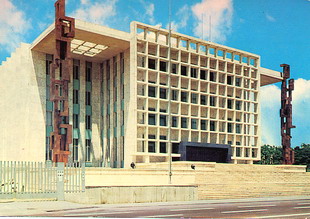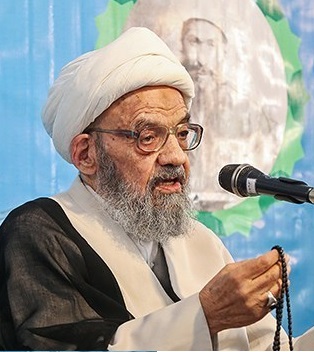
Ruhollah Musavi Khomeini was an Iranian Islamic revolutionary, politician and religious leader who served as the first Supreme Leader of Iran from 1979 until his death in 1989. He was the founder of the Islamic Republic of Iran and the main leader of the Iranian Revolution, which overthrew Mohammad Reza Pahlavi and ended the Iranian monarchy. Ideologically a Shia Islamist, Khomeini's religious and political ideas are known as Khomeinism.

Sayyed Mohammad Hosseini Beheshti was an Iranian jurist, poetic philosopher, cleric and politician who was known as the second person in the political hierarchy of Iran after the Revolution. Beheshti is considered to have been the primary architect of Iran's post-revolution constitution, as well as the administrative structure of the Islamic republic. Beheshti is also known to have selected and trained several prominent politicians in the Islamic Republic, such as former presidents Hassan Rouhani and Mohammad Khatami, Ali Akbar Velayati, Mohammad Javad Larijani, Ali Fallahian, and Mostafa Pourmohammadi. Beheshti also served as the Secretary General of the Islamic Republic Party, and was the head of the Iranian judicial system. He further served as Chairman of the Council of Islamic Revolution, and the Assembly of Experts. Beheshti earned a PhD in philosophy, and was fluent in English, German and Arabic.

Grand Ayatollah Hussein-Ali Montazeri was an Iranian Shia Islamic theologian, Islamic democracy advocate, writer, and human rights activist. He was one of the leaders of the Iranian Revolution and one of the highest-ranking authorities in Shīʿite Islam. He was once the designated successor to the revolution's Supreme Leader, Ayatollah Khomeini; they had a falling-out in 1989 over government policies that Montazeri claimed infringed on people's freedom and denied them their rights, especially after the 1988 mass execution of political prisoners. Montazeri spent his later years in Qom and remained politically influential in Iran but was placed in house arrest in 1997 for questioning "the unaccountable rule exercised by the supreme leader", Ali Khamenei, who succeeded Ruhollah Khomeini. He was known as the most knowledgeable senior Islamic scholar in Iran, a grand marja of Shia Islam, and was said to be one of Khamenei's teachers.
Special Clerical Court, or Special Court for Clerics is a special Iranian judicial system for prosecuting crimes, both ordinary and political, committed by Islamic clerics and scholars. The Special Clerical Court can defrock and disbar Islamic jurists, give sentences of imprisonment, corporal punishment, execution, etc. The court functions independently of the regular Iranian judicial framework, with its own security and prison systems, "generally secret and confidential" cases, proceedings and procedures, and is accountable only to the Supreme Leader of Iran,. The most senior Islamic politician to be prosecuted and sentenced to prison since the Iranian Revolution was Abdollah Nouri who was sentenced to five years in prison for political and religious dissent by the court in 1999.

Mohsen Kadivar is a mujtahid, Islamic theologian, philosopher, writer, leading intellectual reformist, and research professor of Islamic Studies at Duke University. A political Iranian dissident, Kadivar has been a vocal critic of the doctrine of clerical rule, also known as Velayat-e Faqih, and a strong advocate of democratic and liberal reforms in Iran as well as constructional reform in understanding of shari'a and Shi'a theology. Kadivar has served time in prison in Iran for his political activism and beliefs.
The Shia clergy are the religious leaders of Shia Islam. Shia Islam places great importance on the guidance of clergy, and each branch of Shi'ism maintains its own clerical structure. The most well-known Shia clergy belongs to the largest branch of Shia Islam, Twelver Shi'ism. As in other branches of Islam, Shia scholars are collectively known as the ulema. Individual clerics are referred to as mullah or ākhūnd, but because those terms have developed "a somewhat pejorative connotation" since at least the 1980s, the term rūḥānī has been "promoted" as an alternative, "especially by the clerical class itself".

Islamic Government, or Islamic Government: Jurist's Guardianship is a book by the Iranian Shi'i Muslim cleric, jurist and revolutionary, Ayatollah Ruhollah Khomeini. First published in 1970, it is perhaps the most influential document written in modern times in support of theocratic rule.
The Guardianship of the Islamic Jurist is a concept in Twelver Shia Islamic law which holds that until the reappearance of the "infallible Imam", at least some of the religious and social affairs of the Muslim world should be administered by righteous Shi'i jurists (Faqīh). The nature of these affairs are disputed.

Khomeinism, also transliterated Khumaynism, refers to the religious and political ideas of the leader of the 1979 Iranian Islamic Revolution, Ruhollah Khomeini. In addition, Khomeinism may also refer to the ideology of the clerical class which has ruled the Islamic Republic of Iran, founded by Khomeini. It can also be used to refer to the "radicalization" of segments of the Twelver Shia populations of Iran, Iraq, and Lebanon, and the Iranian government's "recruitment" of Shia minorities in Afghanistan, Pakistan, Saudi Arabia, and Africa. The words Khomeinist and Khomeinists, derived from Khomeinism, can also be used to describe members of Iran's clerical rulers and attempt to differentiate them from "regular" Shia Muslim clerics.

The Assembly for the Final Review of the Constitution also known as the Assembly of Experts for Constitution, was a constituent assembly in Iran that was convened in 1979 to condense and ratify the draft prepared beforehand for the Constitution of the Islamic Republic of Iran.

Grand Ayatollah Asadollah Bayat-Zanjani is an Iranian theologian, Islamic philosopher, writer and Grand marja of Islam. He has published objections to Iran's system of Islamic Jurist Guardianship known as velayat-e faqih, asserting that this system is not founded on Islam.

Ayatollah Sayyid Mohammad-Ali Mousavi Jazayeri is an Iranian Twelver Shia cleric, who was the representative of Vali-Faqih in Khuzestan province from 1983 to 2019. He was elected by the order of Sayyid Ruhollah Khomeini, who was the previous Supreme Leader of Iran.

The Supreme Leader of Iran, also referred to as Supreme Leader of the Islamic Revolution, but officially called the Supreme Leadership Authority, is the head of state and the highest political and religious authority of the Islamic Republic of Iran. The armed forces, judiciary, state radio and television, and other key government organizations such as the Guardian Council and Expediency Discernment Council are subject to the Supreme Leader. According to the constitution, the Supreme Leader delineates the general policies of the Islamic Republic, supervising the legislature, the judiciary, and the executive branches. The current lifetime officeholder, Seyyed Ali Hosseini Khameneh known as Ali Khamenei, has issued decrees and made the final decisions on the economy, the environment, foreign policy, education, national planning, and other aspects of governance in Iran. Khamenei also makes the final decisions on the amount of transparency in elections, and has dismissed and reinstated presidential cabinet appointees.
Marja' is a title given to the highest level of Twelver Shia religious cleric, with the authority given by a hawzah to make legal decisions within the confines of Islamic law for followers and clerics below him in rank. The highest ranking marjiʿ is known as the marja al-mutlaq or marja al-taqlid al-mutlaq. A marji' is usually also a grand ayatollah.

Mohammad Reza Naseri-Yazdi is an Iranian Twelver Shia cleric who is the representative of Yazd province and the Imam of Friday in the city of Yazd, who was appointed at the mentioned positions by the decree of Iran's supreme leader, Seyyed Ali Khamenei on 28 July 2011.

Seyed Kazem Noor Mofidi is a Supreme Leader's representative in Golestan Province, the leader of congregational Friday prayers of Gorgan, and a former member of the Assembly of Experts in Iran. He is considered the oldest Friday prayer leader in the country and the only representative of the reformist Supreme Leader in Iran.

Sheikh Ahmad Mohseni Garakani Persian: شیخ احمد محسنی گرکانی, is an Iranian Ayatollah. He was the Imam of Friday Prayer in Tuyserkan and the Chief of the Supreme Court of Iran, as well as representing the people of Markazi province in the Assembly of Experts from 1998 to 2024.

Shia Islamism is the usage of Shia Islam in politics. Most study and reporting on Islamism has been focused on Sunni Islamist movements. Shia Islamism, a previously very small ideology, gained in popularity after the Iranian Revolution led by Ruhollah Khomeini, whose Shia Islamist policies became known as Khomeinism. However, there are also Shia Islamist movements outside of Khomeinism, such as the Islamic Dawa Party of Muhammad Baqir al-Sadr and the Sadrist Movement of Muqtada al-Sadr.
Molla Ahmad Naraqi also known as known as “Fauzel Narauqee”, was a Shi'i cleric ("mullah"), who has been called "the first Shi‘i jurisprudent to argue for wilayat al-faqıh al-siyasıyah, or "the divine mandate of the jurisprudent to rule" during the occultation of the Imam. The concept of wilayat al-faqıh or Velayat-e Faqıh came to the attention of the world when Ayatollah Ruhollah Khomeini led the Islamic Iranian Revolution in 1978-9 and established the Islamic Republic of Iran using wilayat al-faqıh as its governing principal. Naraqi's work called for the system in his technical fiqh work entitled Awa’id al-ayyam predating the call by the Ayatollah Ruhollah Khomeini for this system in his lectures and book Islamic Government by more than a century.
Shia opposition to the Islamic Republic of Iran refers to Shia Muslims who oppose the Islamic Republic of Iran, which is a Shia theocracy established after the Iranian revolution.














